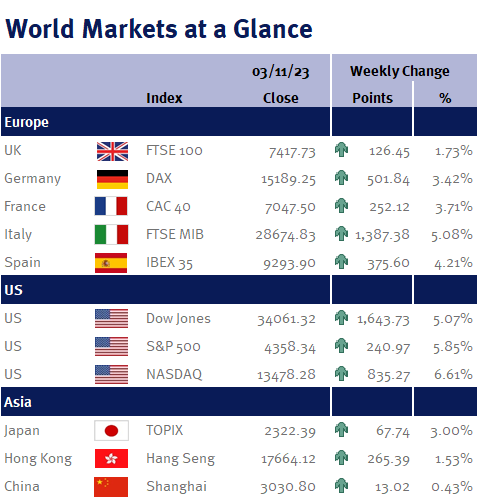Powell’s commentary led markets to believe the next step in interest rates is likely to be a cut, however the robustness of the US economy (GDP rising 4.9% in Q3) and the labour market suggests that we may have to wait until 2024 for the first rate cut.
Stocks also reacted positively to a slowdown in the US labour market. The US economy added 150,000 jobs in October falling short of the 180,000 anticipated. The unemployment rate also edged up to 3.9% last month the highest since January 2022. With labour market data closely watched by the Fed, signs any weakness should support the case for the Central Bank to refrain from further rate hikes this year.
The Bank of England followed suit, opting to maintain the base interest rate at 5.25%. Alongside this decision, the Bank revised its growth projections for the UK economy, estimating 0.1% growth for the rest of the year and remain flat in 2024. Governor Andrew Bailey underscores the effectiveness of higher interest rates in addressing inflation concerns however, he noted that “there is no room for complacency as inflation is still too high” emphasizing that it’s too early to consider rate cuts. In the near term, the bank anticipates a more pronounced decline in inflation over the coming months, forecasting it falling just below 5% and remain at this level for the rest of the year. This drop is largely attributed to decreasing energy prices, although there are potential inflation risks stemming from tragic events in the Middle East. As we’ve previously mentioned, the Bank’s analysis indicates that the full impact of interest rate hikes on households is yet to materialise with many still enjoying the benefits of lower mortgage rates. Nevertheless, the economy is already grappling with the consequences of higher rates.
Despite caution against premature considerations of rate cuts reiterated by the US and UK central banks, traders have responded by speculating that their decision to keep interest rates high for an extended period may ultimately lead to more substantial rate reductions in the coming year.
In these uncertain times, it is crucial to maintain vigilance, as policymakers must delicately balance monetary policy with the needs of economic growth in the face of a slowing economy. While rate cuts may not be on the immediate horizon, the potential for further adjustments remains.
Data-wise, next week we are expecting China’s balance of trade, UK retail sales and European retail sales. We also have China’s inflation data, US initial jobless claims and UK GDP.
Kate Mimnagh, Portfolio Economist


